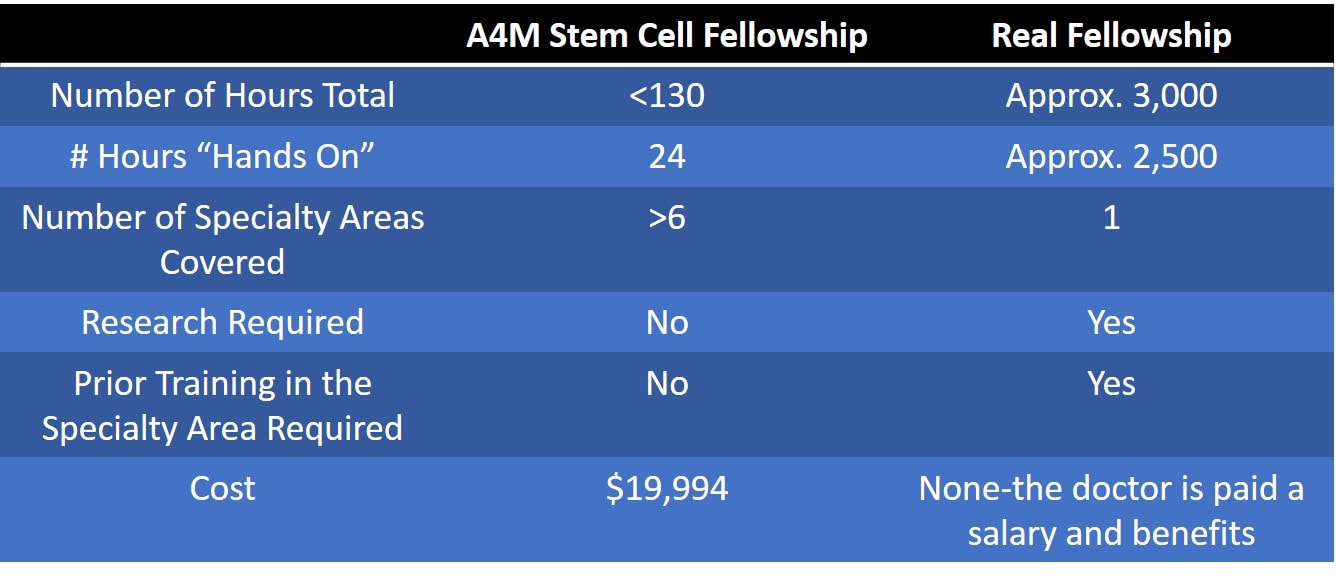Interventional Orthopedics Training – What Patients Should Know About Their Doctor
Recently, we’ve noticed several physicians advertising that they have completed “stem cell fellowship training”. So what is this and is it a real medical fellowship in the same way your cardiologist or other specialist went through fellowship training, or is it something else?
What is Fellowship Training?
A fellowship is usually a dedicated 1-2 year training program, where a physician who has completed his basic specialty training becomes a subspecialist. This means that the doctor becomes even more specialized. For example, a doctor completing internal medicine training may opt to pursue subspecialty training in cardiology by undergoing a fellowship. During this 1-2 year period, the doctor in training typically works 50-60 hours a week, at first under supervision and then as he or she learns more, under less supervision. So at the end of a one-year fellowship, the doctor has had thousands of hours of hands on training. In addition, the physician is usually required to pursue and publish research in the area, demonstrating a deep knowledge of the subject.
How Their “Stem Cell Fellowship Training” Differs from a Real Fellowship Program
The “stem cell fellowship training” we have seen advertised on stem cell clinic websites is very different from the real deal. This “fellowship” is comprehensive course given by a for-profit organization – The American Academy of Anti-Aging Medicine (a.k.a. A4M). This program is five modules and unlike a real fellowship, has a minimal hands-on component. So rather than a year spent intensively learning a subject over thousands of hours and publishing research to demonstrate mastery, this is four “do it yourself” online courses that total less than a hundred hours of education, a three day “hands-on” course, and a test. So in under 130 hours, you can learn everything there is to know about stem cell therapy in all major disciplines including cardiology, pulmonary, orthopedics, neurology, dermatology, vascular disease, cosmetics, and more!
Compare this “stem cell fellowship training” to our Interventional Orthopedics Fellowship that focuses heavily on stem cells:
Also note some big differences. To be qualified for a real fellowship, you have to take years of prerequisite training in that specialty area. There is no such training required for the A4M stem cell fellowship training. In fact, you don’t even need to be a medical doctor, you can be a dentist! That last part is a bit scary, as this “fellowship” covers everything from cardiology to cosmetic surgery. Also note that the A4M “fellowship” requires you to pay almost twenty thousand dollars for this training! Contrast that to a real fellowship where the doctor is paid a salary and benefits for the 1-2 year period while he learns.
What a Real Stem Cell Fellowship Looks Like
We’re on our fourth year of running a real stem cell fellowship focused on Interventional Orthopedics. To be able to call it a “fellowship” we offer thousands of hours of didactic and hands-on training over a one year period. Fellows have to demonstrate competency in about 100 separate image-guided injection procedures just in the world of orthopedic injury. They also have to complete original research and hopefully publish this in the peer reviewed literature. In addition, they must have a prerequisite medical specialty board (like Physical Medicine), plus they should have mastered basic fluoroscopy-guided spine and ultrasound peripheral joint injections just to be considered a candidate. For this reason, we turn away about two-thirds of the doctors with the right specialty training because they don’t have the additional advanced injection education.
The real differences between the two programs came into sharp focus when I went back and forth with the chat box on the A4M website. This was a sales person trying hard to get me on the phone so he could sell me a 20K course. He boasted that the program was affiliated with a medical school, but when I asked if the 3 days of “hands-on” training actually happened at a medical school, I was told that this would happen in a private family practice clinic focusing on facial aesthetics! When I balked at paying 20K for the training, he boasted that the “fellowship” had a thousand hours of content. When I corrected him that it only really had about 120 hours of education, he admitted his math error.
The upshot? When you see a doctor advertising that he is “fellowship trained” in stem cells by the American Academy of Anti-Aging Medicine (a.k.a. A4M), this is a bit of a stretch and tells you quite a bit about the doctor and the clinic. In the wild west of weekend stem cell courses, this is just another course, albeit a comprehensive and expensive one. Given that we run one of the few legitimate “stem cell fellowships” in the country (which is actually focused on interventional orthopedics), it’s very unlikely that any US physician has taken a real one year fellowship in any subspecialty where the focus was stem cell therapy. So don’t be fooled, as calling this expensive course a fellowship is a huge stretch!

If you have questions or comments about this blog post, please email us at [email protected]
NOTE: This blog post provides general information to help the reader better understand regenerative medicine, musculoskeletal health, and related subjects. All content provided in this blog, website, or any linked materials, including text, graphics, images, patient profiles, outcomes, and information, are not intended and should not be considered or used as a substitute for medical advice, diagnosis, or treatment. Please always consult with a professional and certified healthcare provider to discuss if a treatment is right for you.
